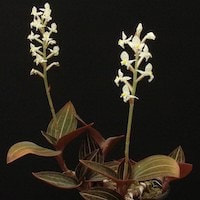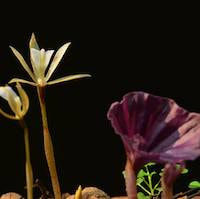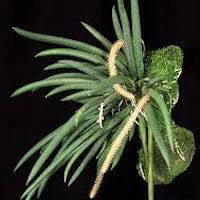WC1 - Women's Citrus 1 - A legend in ones own lime
|
Bulbophyllum Vaginatum is a plant from Singapore that blooms after heavy rain in hot weather. It has a delicate scent like citrus mixed with a bit of sweetness and lychee. In Java, people boil its fruit to help with earaches.
Researchers at the National University of Singapore found 21 different compounds in Bulbophyllum Vaginatum. Bulbophyllum Vaginatum also has a special molecule called phenanthro(4,3-b)furan. It's not clear if this molecule gives the plant its medicinal benefits. But historically, people from India, China, and Africa have used this orchid to treat problems like coughs and bronchitis. |
|
Ludisia discolor (Ker.-Gawl.) A. Rich.
Ludisia discolor, known by various names across Asia, has a creeping root and blooms in March in Singapore. In Traditional Chinese Medicine, it's used year-round, fresh or dried, with a sweet taste and cooling effect. In Hong Kong, it treats conditions like coughing up blood, neurasthenia, and anorexia. In mainland China, it's used to nourish fluids, benefit lungs, and stop bleeding, while its rhizomes are used in Thai medicine for insect bites. |
|
Nervilia fordii (Hance) Schultze
N. fordii, also known as Qingtiankui or Tiankui, contains flavonoids and coumarin compounds with antimicrobial and anti-inflammatory effects. In Vietnamese medicine, its leaves are used for tuberculosis and abscesses. In Traditional Chinese Medicine, Qingtiankui treats lung issues, stomach problems, and pain, and it's applied for various conditions like bronchitis and inflammation, even given to children for nutrition in Guangxi province. |
|
Oberonia cavaleriei Finet. Syn. Oberonia myosurus (Forster) Lindl.
Bangyeyuanwei Lan, also known as Yancong, blooms from August to October and is found in regions like Sichuan, Yunnan, Guizhou, and others across China, plus Vietnam, Thailand, Myanmar, and Nepal. In Traditional Chinese Medicine, it's used fresh or dried to cool the body, stop bleeding, and treat injuries like fractures. It's also used for ear infections, bruises, dog bites, and plant poisoning. In Nepal, its tubers are used for liver issues. |
Other scent note
Grapefruit, Mulberry, Persimmon, Yellow cherry, Mangosteen, Kiwi and Peac
Scentopia Library Reference ingredient
Download the guided mediation that works best with this Orchid fragrance oil designed for Women
| women_citrus_essential_oil_orchi_00001.mp3 | |
| File Size: | 111079 kb |
| File Type: | mp3 |



